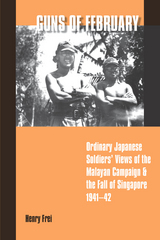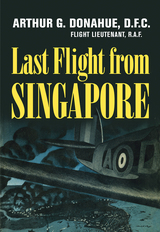2 books about Siege, 1942

Guns of February
Ordinary Japanese Soldiers' Views of the Malayan Campaign and the Fall of Singapore, 1941-42
Henry Frei
National University of Singapore Press, 1990
Guns of February shows the Fall of Singapore and Japan's 1941 military campaign in Malaya through the eyes of Japanese soldiers who took part, based on interviews, memoirs, war diaries, and other Japanese-language sources. Although an enormous number of books have been published on Japan's wartime advance into Southeast Asia, few books in English make much use of Japanese sources, and they reveal little of what happened on the Japanese side. In the words of the author, the Japanese"'advance by brigade groups', 'outflank the defence', 'sustain many casualties', and remain altogether a largely faceless mass bicycling their way down to Singapore." In Guns of February some of the voices of these soldiers are finally heard, and they tell a fascinating story. A few of them were professional soldiers who served their country with commitment and dedication, but many were conscripts hoping to stay alive, curious and apprehensive about the countries they entered, and moved by the plight of the people whose cities and towns they sometimes destroyed. Many were young men, interested in girls and in the sights and sounds of Southeast Asia, but also missing their families and the familiar world of Japan. It is a picture far removed from the staple view of the remorseless and fanatic Japanese soldier totally devoted to his Emperor and determined to die for his country. In writing this account of the Japanese advance on Singapore, the author attempted to show the universal humanity of the actors concerned.
[more]

Last Flight from Singapore
Arthur G. Donahue
Westholme Publishing, 2014
The First American Volunteer to Serve in the RAF During World War II Who Fought in the Battle of Britain and Then Defended Singapore Against the Japanese Invasion
As one of the storied few who defeated the Nazi Luftwaffe during the Battle of Britain, American Arthur G. Donahue—Royal Air Force Flight Lieutenant and recipient of the Distinguished Flying Cross—wished to continue his service and requested overseas duty. In October 1941, he was sent to the British protectorate of Singapore as a precaution against a possible threat from Japan, which was already conducting a war in China. Within two months, all of Asia was thrown into turmoil as Japan simultaneously bombed Hawaii and invaded the Philippines and the Dutch East Indies. Japanese forces swiftly conquered much of Southeast Asia and began moving toward Burma and India. Standing in the face of this onslaught was the British stronghold of Singapore. Donahue and his squadron began around-the-clock sorties, reminiscent of their battle against Germany a little more than one year earlier. This time, however, the British forces were overwhelmed and they were forced to surrender the city to the Japanese in February 1942, an event Winston Churchill called “the worst disaster” in British history. During the final phase of the battle, Donahue was wounded while strafing Japanese transports unloading troops to storm Singapore. He managed to land, and was airlifted on the last flight from the city and ultimately to a hospital in India.
In Last Flight from Singapore, Donahue tells his dramatic story, accompanied by photographs he took himself, of the intense and futile battle against the Japanese for control of the gateway to the Malay Peninsula. He continues his story through his convalescence to his return to England, where he once again began patrols over Europe. The manuscript for Last Flight from Singapore was found among his effects after he did not return from a patrol in 1942 and was presumed lost.
In Last Flight from Singapore, Donahue tells his dramatic story, accompanied by photographs he took himself, of the intense and futile battle against the Japanese for control of the gateway to the Malay Peninsula. He continues his story through his convalescence to his return to England, where he once again began patrols over Europe. The manuscript for Last Flight from Singapore was found among his effects after he did not return from a patrol in 1942 and was presumed lost.
[more]
READERS
Browse our collection.
PUBLISHERS
See BiblioVault's publisher services.
STUDENT SERVICES
Files for college accessibility offices.
UChicago Accessibility Resources
home | accessibility | search | about | contact us
BiblioVault ® 2001 - 2024
The University of Chicago Press









